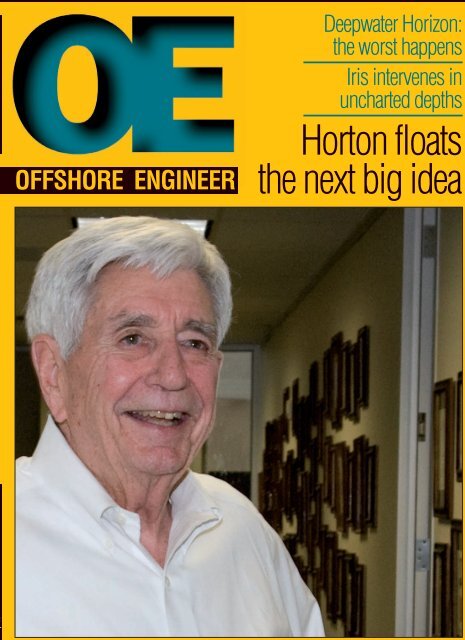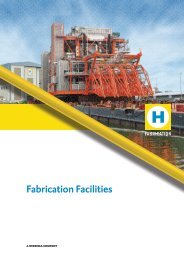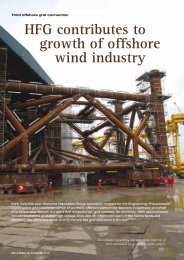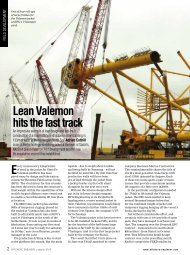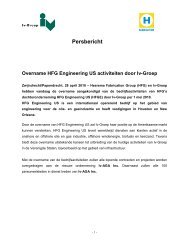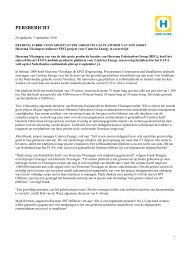Giant Valhall deck set for June sailaway - Heerema Fabrication Group
Giant Valhall deck set for June sailaway - Heerema Fabrication Group
Giant Valhall deck set for June sailaway - Heerema Fabrication Group
You also want an ePaper? Increase the reach of your titles
YUMPU automatically turns print PDFs into web optimized ePapers that Google loves.
Deepwater Horizon:<br />
the worst happens<br />
Iris intervenes in<br />
uncharted depths<br />
OFFSHORE ENGINEER<br />
Horton floats<br />
the next big idea
‘We believe there is to some extent a revival of the North Sea market<br />
with sufficient projects, including a couple of large projects.’<br />
Tino Vinkesteijn<br />
<strong>Giant</strong> <strong>Valhall</strong> <strong>deck</strong><br />
<strong>set</strong> <strong>for</strong> <strong>June</strong> <strong>sailaway</strong><br />
The BP <strong>Valhall</strong><br />
re-development main <strong>deck</strong><br />
nearing completion at<br />
<strong>Heerema</strong> Zwijndrecht in<br />
late March.<br />
The 11,000t integrated production and hotel <strong>deck</strong> <strong>for</strong> BP Norge’s <strong>Valhall</strong> redevelopment project is on schedule to leave <strong>Heerema</strong><br />
<strong>Fabrication</strong> <strong>Group</strong>’s Zwijndrecht facility in mid <strong>June</strong>. At peak around 1200 people were working simultaneously on the project, which has<br />
taken the Dutch yard more than two million man hours to complete. Meg Chesshyre visited the yard as it geared up <strong>for</strong> the final push.
‘This is a truly international<br />
project with a very large<br />
number of participants.’<br />
Koos Herweijer<br />
‘We’ve seen yards from the<br />
Gulf of Mexico, who would<br />
traditionally stick to that side<br />
of the ocean, bidding here in<br />
Europe.’<br />
Nick Routledge<br />
The Zwijndrecht yard’s main<br />
<strong>deck</strong> contract covers fabrication,<br />
integration and load-out onto<br />
barges <strong>for</strong> transportation to the final<br />
location offshore Norway. The design<br />
was executed by Mustang Engineering.<br />
<strong>Heerema</strong>’s contract also includes a 350t<br />
flare boom, nine bridges varying in<br />
weight from 24 to 250t and three towers<br />
of 29t, 40t and 41t, required because<br />
the water depth at the <strong>Valhall</strong> field has<br />
increased by about 5.4m because of seabed<br />
subsidence since the facilities were first<br />
installed in 1981/2.<br />
The new plat<strong>for</strong>m, with a design life<br />
of 40 years, bed capacity of 180 and a<br />
production capacity of 150,000b/d of oil<br />
and 5mmcm/d of gas, will be supplied<br />
with green power via a 292km long direct<br />
current power cable from Lista, south<br />
Norway, using ABB’s proprietary DC-AC<br />
converter technology. The plat<strong>for</strong>m’s<br />
jacket and piles have been fabricated at<br />
Norway’s Aker Verdal yard. Saipem has<br />
the offshore installation contract.<br />
Deck fabrication started at Zwijndrecht<br />
in November 2007. An additional contract<br />
<strong>for</strong> the construction of a 2100t weather<br />
<strong>deck</strong> module (42x35x16m) <strong>for</strong> the project<br />
was awarded to HFG in <strong>June</strong> 2009.<br />
The biggest challenge posed by the <strong>deck</strong><br />
is its sheer size, explains commercial<br />
manager Koos Herweijer. Measuring<br />
100x47x50m, it is being hailed as one of<br />
the largest objects ever designed and built<br />
to be lifted as a single lift. Despite the<br />
fact that <strong>Heerema</strong> Zwijndrecht owns the<br />
largest indoor fabrication facility in the<br />
Netherlands, the unit had to be moved<br />
outside in January 2010 due to limited<br />
space inside the hall to complete the <strong>deck</strong>.<br />
Herweijer says the construction<br />
philosophy is Gulf of Mexico, meaning<br />
that it is based largely on skid-mounted<br />
units, with packages procured and<br />
designed by others. ‘Our scope is then<br />
to receive and integrate all these units<br />
into one large <strong>deck</strong>,’ he explains. ‘This is<br />
a truly international project with a very<br />
large number of participants. The design<br />
has been done in Houston; the client is in<br />
Norway and skids and other sub-supplies<br />
have come from fabricators in Europe<br />
and from companies all over the world.<br />
It has been a challenge because of the<br />
number of parties involved, and their<br />
being spread over so many continents and<br />
the various time zones.’<br />
The stats <strong>for</strong> <strong>deck</strong> fabrication materials<br />
and consumables also make impressive<br />
reading. As well as absorbing some 5000t<br />
of steel and making extensive use of<br />
corrosion-resistant alloys, with 10km of<br />
duplex piping up to 36in diameter and<br />
7km of titanium piping up to 30in, the<br />
completed <strong>deck</strong> will have some 18km of<br />
cable trays, 400km of cable, 7km of tubing<br />
and 12,500 cable terminations.<br />
‘This project demonstrates our<br />
capabilities in managing complex, multidisciplinary<br />
projects,’ comments Tino<br />
Vinkesteijn, who took over as managing<br />
director of <strong>Heerema</strong> Zwijndrecht and<br />
<strong>Heerema</strong> Vlissingen last September<br />
having previously worked in the power<br />
industry as president of Belgian firm CMI<br />
Energy Engineering.<br />
Vinkesteijn says the order book at<br />
HFG’s Dutch yards at this moment is<br />
full until late summer. ‘2009 was a<br />
relatively slow year,’ he adds. ‘Luckily<br />
we didn’t need any orders because we<br />
were full.’ In addition to the <strong>Valhall</strong><br />
<strong>deck</strong>, the Zwijndrecht yard is also<br />
building some subsea structures ures <strong>for</strong><br />
BP Angola, block 31.<br />
There is a new wave of projects<br />
in the pipeline with the first<br />
couple of awards due in the<br />
early summer. A second wave is<br />
anticipated in the fourth quarter<br />
of 2010, where some more decisions will<br />
be made. ‘The total volume is far higher<br />
than our capacity, so we hope to take<br />
some of those projects out of the water,’<br />
notes Vinkesteijn. The North Sea is going<br />
to stay HFG’s main, home market, he<br />
adds. ‘We believe there is to some extent<br />
a revival of that North Sea market with<br />
sufficient projects, including a couple of<br />
large projects.’ He warns, however, that<br />
there are some yards without work at the<br />
moment so no doubt there will be price<br />
competition.<br />
He believes the North Sea market<br />
will show a declining trend in the long<br />
term, but then again points out: ‘We also<br />
thought that five years ago!’ At the same<br />
time HFG is obviously looking at other<br />
business opportunities and possibilities<br />
Other items being fabricated by <strong>Heerema</strong><br />
<strong>for</strong> BP’s VRD project include a 2100t<br />
weather <strong>deck</strong> module and (in<strong>set</strong>) t<br />
nine<br />
bridges varying in weight from<br />
24t to 250t.
By mid-January the <strong>deck</strong> had run out of space in Zwijndrecht’s fabrication hall and had<br />
to be moved outside on 70 Mammoet multiwheel trailers <strong>for</strong> completion.<br />
elsewhere. West Africa is an option. An<br />
attempt to enter the Nigerian market<br />
came to nothing because of the political<br />
risk there, and HFG is now withdrawing.<br />
Kazakhstan and Brazil are both seen as<br />
highly potential markets.<br />
The <strong>Heerema</strong> <strong>Group</strong>, comprising,<br />
<strong>Heerema</strong> <strong>Fabrication</strong> <strong>Group</strong> and<br />
Heeerema Marine Contractors (HMC),<br />
is currently examining how it will<br />
participate in these markets in the<br />
future, and expects to have some answers<br />
shortly. Currently HMC and HFG<br />
have independent strategies, but they<br />
know each other well having worked<br />
together <strong>for</strong> many years. It is anticipated<br />
that co-operation between the group’s<br />
engineering, fabrication and marine<br />
installation arms is going to be closer in<br />
the future.<br />
One of the competencies <strong>Heerema</strong><br />
is trying to continue to build is EPC<br />
contracting with fabrication-oriented<br />
engineering being the key. Vinkestejn<br />
says the fabricator is currently the last<br />
part of the train. ‘The barge is going to<br />
sail away at a certain date, because the<br />
lift is secured, so we have to compensate<br />
<strong>for</strong> everything that happens early on<br />
in the design and procurement phase,’<br />
he explains. <strong>Heerema</strong> is also looking at<br />
participating in the design, construction<br />
and installation of offshore wind<br />
substructures, and at the design and<br />
fabrication of substructures <strong>for</strong> deeper<br />
waters.<br />
Asked how he saw the offshore wind<br />
market developing, Vinkesteijn says that<br />
whereas there is no doubt there is a very<br />
strong drive politically, it is hard to tell<br />
at what speed. All the projections so far<br />
have moved upwards, he says, and there<br />
are so many regulatory, finance and<br />
supply chain issues still to be resolved.<br />
HFG had already proved its competency<br />
by building a trans<strong>for</strong>mer plat<strong>for</strong>m at<br />
the Vlissingen yard <strong>for</strong> installation in<br />
German waters (OE April 2008), and the<br />
group’s Hartlepool yard has built an<br />
offshore collector substation <strong>for</strong> Greater<br />
Gabbard and is currently building two<br />
substation topsides <strong>for</strong> another UK<br />
offshore wind farm, Sheringham Shoal.<br />
<strong>Heerema</strong>’s engineering arm, HFG<br />
Engineering, was <strong>for</strong>med following the<br />
acquisition of US-based consulting firm<br />
Albert-Garaudy Associates (AGA) in<br />
late 2006. It works both with HFG and<br />
independently doing concept studies<br />
with the added experience of how yards<br />
operate. The US office has carried out<br />
engineering work and concept studies <strong>for</strong><br />
floaters in the Gulf of Mexico. In Europe<br />
it has done some FEED work <strong>for</strong> Statoil,<br />
and is also busy with topsides design,<br />
wind farm work and concept studies.<br />
‘We’ve been bidding ourselves<br />
crazy,’ says Nick Routledge, business<br />
development manager at HFG<br />
Engineering Europe. ‘I’d almost say we<br />
have hardly ever seen so many prospects,’<br />
but, he wonders, ‘How many of these are<br />
really going to happen’ He agrees that<br />
following on from 2009 yards are hungry<br />
<strong>for</strong> work. ‘We’ve seen yards from the Gulf<br />
of Mexico, who would traditionally stick<br />
to that side of the ocean, who’ve been<br />
bidding here in Europe.’ At HFG, he adds,<br />
‘we can do a lot in a very short time, and<br />
so if the schedule is shorter we have a<br />
little bit of an advantage’.<br />
Routledge was involved in the AGA<br />
acquisition and subsequently spent three<br />
years in Houston as HFG Engineering’s<br />
VP projects, but he also has a strong<br />
fabrication pedigree. After joining HFG as<br />
project manager in 1998, he successfully<br />
executed three projects at Zwijndrecht<br />
be<strong>for</strong>e moving to the <strong>Heerema</strong> Tønsberg<br />
yard in Norway to manage Ringhorne’s<br />
fabrication and then returning to the<br />
Netherlands as project manager on De<br />
Ruyter.<br />
Incorporating BP and Mustang’s<br />
further development of the initial <strong>Valhall</strong><br />
<strong>deck</strong> design presented challenges along<br />
the way, but they were overcome by<br />
working together, reports HFG. Another<br />
challenge – weight – was dealt with by<br />
introducing the separate weather <strong>deck</strong><br />
module, also successfully fabricated at<br />
the yard. Despite numerous changes<br />
and additions, ‘our work on BP’s <strong>Valhall</strong><br />
project is on schedule’, declares Routledge<br />
proudly.<br />
‘That is what we take a pride in, good<br />
quality and on schedule, so that the<br />
client ultimately has a lower risk,’ he<br />
adds. ‘They can rely on getting their<br />
installation on time and to a high quality.’<br />
Emphasizing the importance of<br />
engineering being aligned to the needs<br />
of fabrication, Routledge says: ‘The way<br />
they build <strong>deck</strong>s here is in layers, so you<br />
have to go to a very high level of detail<br />
in the engineering on the lower levels<br />
to ensure that they are pretty much<br />
finalized in terms of structural steel and<br />
supports.’ A more traditional approach<br />
would be to look at the total plat<strong>for</strong>m as a<br />
whole as opposed to splitting it back down<br />
into the different sections, he notes.<br />
The fabrication-led engineering<br />
approach means looking at structural<br />
details where a stand-alone engineering<br />
might be looking to optimize engineering<br />
and add stiffness to lower the quantity of<br />
steel, he says. ‘We can make a judgment<br />
and say it is actually simpler to put a<br />
little bit more steel into the <strong>deck</strong>, keep<br />
the profiles all very similar, and in that<br />
way make it much easier and faster<br />
to fabricate.’ There were many other<br />
examples on the electrical, piping and<br />
piping installation sides, he adds.<br />
On the wind farm front, Routledge<br />
says HFG has been ‘very successful at<br />
designing and building the substation<br />
plat<strong>for</strong>ms’ but that financing remains a<br />
problem in this sector. There have been<br />
many recent proposals <strong>for</strong> offshore wind<br />
farm developments yet the majority are<br />
still in the market place, he stresses,<br />
pointing out that some consortia being<br />
<strong>for</strong>med without a big oil company behind<br />
them were at the whim of financial<br />
groups, while traditional electrical utility<br />
companies backing the projects had to<br />
organize themselves to adopt offshore<br />
practices. OE


